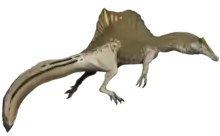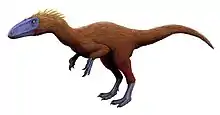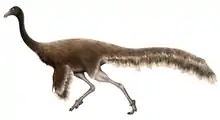Erythrovenator
Erythrovenator is a genus of basal theropod dinosaurs from the Late Triassic of Rio Grande so Sul, Brazil. It contains a single species, Erythrovenator jacuiensis. The genus name translates to "red hunter", in reference to the red color of its fossil, while the specific name references a nearby river, Rio Jacuí. Erythrovenator is one of the earliest known theropods, hailing from the early Norian (or possible late Carnian) Niemeyer Site of the Candelária Sequence in the Santa Maria Supersequence. No other dinosauromorphs are known from this site, which is dominated by the traversodontid cynodont Siriusgnathus. The site probably corresponds to the Riograndia Assemblage Zone based on the presence of Siriusgnathus.[1]
| Erythrovenator | |
|---|---|
 | |
| Skeletal reconstruction of Erythrovenator jacuiensis. Known element in white and unknown in gray. | |
| Scientific classification | |
| Kingdom: | Animalia |
| Phylum: | Chordata |
| Clade: | Dinosauria |
| Clade: | Saurischia |
| Clade: | Theropoda |
| Genus: | †Erythrovenator Müller, 2020 |
| Type species | |
| †Erythrovenator jacuiensis Müller, 2020 | |
The holotype, CAPPA/UFSM 1057, is an isolated proximal portion of the left femur, which had an estimated total length of about 190 millimeters (7.5 inches). The femoral head has a strongly concave lower edge, a rounded inner edge, and a distinct anterolateral tuber, all characteristics of dinosaur femora. It also had small anteromedial and posteromedial tubers, with the former structure quite different from the folded anteromedial tuber of other theropods. The rear surface of the femoral head has a thin vertical ridge in its medial portion and a raised scar in its lateral portion, similar to Buriolestes. There is no evidence for a dorsolateral trochanter, unlike all other known Triassic dinosaurs. On the other hand, the anterior trochanter is a prominent pyramidal structure offset from the shaft by a cleft. This is most similar to neotheropods among early dinosaurs, and is also observed in some silesaurids. Although there is no distinct trochanteric shelf, the anterior trochanter does have a plate-like medial extension.[1]
A phylogenetic analysis placed Erythrovenator as the most basal theropod, supported by the structure of its anterior trochanter. This would make it one of the oldest verifiable theropod known, and one of the few theropods known from the Triassic of Brazil. Other potentially older theropods include Eodromaeus (from Argentina), Nhandumirim and Guaibasaurus (from Brazil), and various herrerasaurids, but these taxa are not universally considered theropods. Lepidus and Camposaurus (from the United States) are theropods which may have a similar age to Erythrovenator.[1]
References
- Rodrigo T. Müller (2020). "A new theropod dinosaur from a peculiar Late Triassic assemblage of southern Brazil". Journal of South American Earth Sciences. in press: Article 103026. doi:10.1016/j.jsames.2020.103026.













